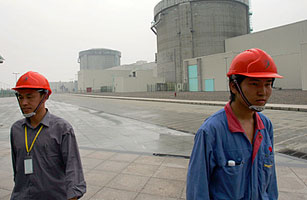
Even for a country known for completing massive infrastructure projects with frightening speed, China’s nuclear-power-plant building spree boggles the mind. China has 13 reactors in operation now and is currently building another 27 — nearly half of the total under construction worldwide. Fifty more are planned and another 110 are in the proposal stage. No other country has a strategy even remotely close in scale.
Yet not even China was immune to the crisis that unfolded at the Fukushima Daiichi nuclear power plant in Japan earlier this month. As European countries from Germany to Poland immediately announced reviews of their nuclear strategies following the near meltdown of the Japanese reactors, China said it, too, would suspend its approval process for new reactors, pending a safety review.
But exactly what kind of effect this will have on China’s nuclear industry remains to be seen. Work will continue on reactors already under construction unless safety issues arise, and a government official has affirmed that the country’s nuclear goals will remain the same. “China will not change its determination and plan for developing nuclear power,” Zhang Lijun, vice minister for environmental protection, said a day after the quake. It seems the most China is prepared to do is slow down — and only a bit.
Given the fact that 80% of its electricity supply comes from coal and the pressure it’s under to reduce its greenhouse-gas emissions, China figures it has little choice but to embrace nuclear power to meet its future energy needs. But the speed with which it wants to boost nuclear production is what’s causing concern. Four years ago, China set a goal of increasing nuclear power capacity from 6.6 gigawatts to 40 gigawatts by 2020. Now, the state media is touting the possibility of reaching nuclear capacity of 40 gigawatts by 2015 and up to 86 gigawatts by 2020. Analysts fear that in the rush to meet such accelerated targets, safety precautions, staff training and regulatory oversight could be compromised.
These concerns are not only being aired outside the country, but also increasingly within China. In April 2009, Li Ganjie, the head of China’s National Nuclear Safety Administration , issued a dire warning to the country, saying, “If we are not fully aware of the sector’s over-rapid expansions, it will threaten construction quality and operation safety of nuclear power plants.” Then, two months ago, a research panel that makes policy recommendations to China’s State Council released a report urging the country to “keep a clear head” with regard to nuclear power and aim for a more realistic 2020 target to avoid shortfalls on uranium, equipment and plant operators. “The events in Japan will give pause at the top of the government, which may now be more willing to heed concerns raised by Chinese safety authorities about getting spread too thin,” says Mark Hibbs, a senior associate in the Carnegie Endowment’s Nuclear Policy Program.
One of the biggest challenges for the NNSA is hiring and training enough skilled inspectors to keep pace with reactor construction, he says. “The Chinese government is certainly aware that they need to do this and it has budgeted for several hundred more personnel at NNSA in recent years,” he says. “But the people they will be hiring will be for the most part young and inexperienced.” The State Council research panel also noted this problem in its report, saying the nuclear-safety agency will need to quadruple its staff of 1,000 inspectors by 2020.
Another worry is corruption. In November, Kang Rixin, the former head of the China National Nuclear Corporation, the country’s largest atomic-plant operator, was sentenced to life in prison for abuse of power and accepting nearly $1 million in bribes — a case that raises obvious questions about safety and the effectiveness of the nuclear regulatory body, but at least shows the government is making an effort to combat corruption. Hibbs says, however, that with so many plants on the way now, more monitoring needs to be done to ensure that the equipment being used in construction is not counterfeit. “The Chinese have to get this issue under control,” he says. “They need to make sure there aren’t any loopholes in their quality-assurance system.”
Despite the problems, China is quick to point out that its reactors are more advanced than those at the 40-year-old Fukushima plant, greatly reducing the chances that a crisis like Japan’s could occur. China’s first plant, which opened at Daya Bay near Hong Kong in 1994, for instance, has pressurized water reactors instead of the boiling-water reactors like those used at Fukushima and containment walls that can survive the impact of a Boeing 747, says C.F. Lee, chair professor in geotechnical engineering at the University of Hong Kong and vice chairman of the advisory board for nuclear safety at Daya Bay. The country also just announced that in April it will start building a next-generation reactor in Shandong province that uses helium gas in the cooling system instead of water and can withstand temperatures near 3,000F for several hundred hours.